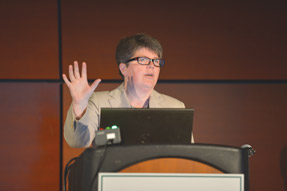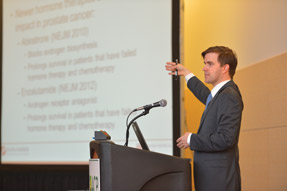Need grows for antimicrobial stewardship
Internists looking for a career in a growth field could consider antimicrobial stewardship. One internist recounts the ups and downs of his chosen profession.
Antimicrobial stewardship has become a growth industry in recent years, said Robert A. Weinstein, MD, FACP, in his talk on the subject at Internal Medicine Meeting 2015.
“If you want to learn a trade, something to do in the hospital that differentiates you from their hospital epidemiologist, from the other ID [infectious disease] physicians, you could in addition be an antimicrobial steward,” said Dr. Weinstein, who is a professor of medicine at Rush University in Chicago and former chair of the Department of Medicine for the Cook County Health and Hospitals System. “It's a noble calling, there will always be business, and hospitals will pay for it.”

As an example of career potential, Dr. Weinstein recalled his first year at Cook County Health and Hospitals System (formerly Cook County Hospital) in Chicago, where he reviewed use of the combination antibiotic amoxicillin and clavulanate potassium. He learned that patients with asthma were receiving it when no antibiotic or a less expensive alternative would be appropriate and restricted its use.
“At the time it was a brand-name drug. We restricted it; you had to call an ID doctor to get it. No one wanted to do that,” he said. “We saved enough money in 1 year to support our intervention activities.”
But the career role can have its downside, too, he cautioned. He was called in for an infectious disease consult for a 25-year-old man with a dramatic case of cellulitis. A clinician had drawn a line to demarcate the lesion, placed the patient on intravenous cefazolin, and called Dr. Weinstein to ask what to step down to for oral therapy.
“I asked the guy, ‘Does this hurt?’ And he said, ‘No, it itches,’” Dr. Weinstein recalled. “So, I asked, ‘What happened here?’ And he said, ‘I was out jogging and I twisted my ankle. So I went to a Chinese apothecary and got some topical agent and put it on my foot.’”
Dr. Weinstein told the clinician that the patient had contact dermatitis; the patient was afebrile and the lesion didn't hurt when he pushed on it. But the clinician responded, “‘Fine, what do I put him on orally?’ And I said, ‘This is contact dermatitis; he needs topical steroids.’ But she said, ‘How do I know it's not superinfected?’”
“Because it's not,” Dr. Weinstein replied. “That's why you called me down here.”
The patient went home on cephalexin. “Shows how much influence I have,” Dr. Weinstein said to laughter from the audience. The anecdote highlights how some clinicians prescribe antibiotics as much for themselves as for the patient. It's better to tell the patient, “This could become superinfected. If it starts to change color, if it gets redder, if it hurts rather than itches, or you get a fever, come back,” Dr. Weinstein described.
The anecdote highlights the larger problems of trying to influence prescribing behavior when it comes to preserving antimicrobials, he said.
There's no question that antimicrobial use drives resistance, he noted. If clinicians can control antibiotic use, they can control resistance complications. As evidence, Dr. Weinstein cited a very old study published in The Lancet about control of infection due to Klebsiella aerogenes in an intensive care unit. As a draconian measure, the researchers stopped use of all antibiotics, which reduced the pressure on the organism to develop resistance and the problem strain disappeared.
Antibiotic stewardship, when use is improved, not only saves lives, it lowers costs, he said. He cited another study on which he had collaborated showing that reducing resistance by 10% in his institution would save as much as $3 million annually for every 1,400 patients.
The 6 Ds
Dr. Weinstein cited 6 Ds, described by the Illinois “Fellowship of the Stewards” and David N. Schwartz, MD, of the Division of Infectious Diseases/Department of Medicine at the John H. Stroger Jr. Hospital of Cook County, as practical advice in managing proper antibiotic use:
Make the right diagnosis. Determine which infection is being treated by using appropriate culture specimens. This is a key step; does the patient have a bacterial infection?
Use debridement when warranted, for example, in diabetic patients with foot ulcers.
Prescribe the right drug, meaning the one that is the most effective and safest, with the narrowest spectrum and lowest cost. Most hospitals have fairly restrictive formularies, Dr. Weinstein said. Ideally, he noted, the pharmacy and infectious disease doctors should work together to make sure the drugs on the formulary are the best fit for local resistance patterns.
Use the right dose. For example, Dr. Weinstein noted that the dose of trimethoprim-sulfamethoxazole to treat a urinary tract infection is different from the dose to treat Pneumocystis pneumonia or a Nocardia infection.
Use the right duration. Some people have begun using procalcitonin levels to determine when to stop antibiotics for intensive care unit patients, Dr. Weinstein said. He explained that the thinking is when the procalcitonin drops below a certain level (and that level depends on which lab a physician uses), it is safe to halt antibiotics; this has been applied to diseases for which there are no good data on when it is appropriate to stop. “As it turns out there are very few infectious diseases for which the duration is known based on randomized, controlled trials. So it's often somewhat of a clinical guess,” he said.
Use the right de-escalation, as indicated by culture results and clinical improvement, such as switching from an intravenous dose to an oral dose.
7 interventions
Dr. Weinstein also cited 7 interventions for reducing antibiotic exposure, adapted from a Perspective published in the Dec. 6, 2012, New England Journal of Medicine:
Promote clear, accessible decision support. To advise on appropriate duration of antibiotic therapy, target common diagnoses and provide links to evidence.
Use standardized order sets. Clearly define the appropriate antimicrobial agent and the dose and duration of treatment. Order sets are “pretty easy,” Dr. Weinstein said.
Use indications that are visible at the point of care. Require the indication to be specified at the time the order is written and highlight the indication on the medication record.
Document the start day and expected duration. Provide visible reminders of the amount of antibiotic received and expected, facilitating awareness and daily decision making. Then include the start day and expected duration in the documentation.
Implement timeouts after 72 hours. At 72 hours, determine if the patient needs to continue antibiotics, just as some facilities do for bladder catheters and IV lines.
Send appropriate cultures before starting antibiotics. Positive cultures help tailor regimens to the narrowest spectrum. Negative cultures reduce anxiety about delaying needed treatments.
Implement prospective audits with feedback. Engage frontline physicians and track progress. Some institutions have an audit built into their ongoing stewardship activities. It's fairly expensive to have someone such as an ID physician or pharmacist go through all records to make sure that patients are on the right drugs, Dr. Weinstein said, but ongoing audits can be very effective.





